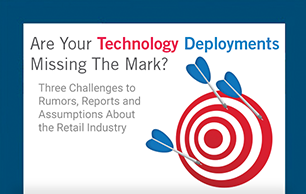With so many technologies that are required to operate every aspect of a business, it’s easy to lose control of costs. Here are six common sources of overspending. If one or more of the following statements characterizes your company, you may be needlessly overspending on technology.
Lack of asset tracking - Many times, large organizations have functional equipment in storage, installed in closed locations, or sitting in the back office. Failure to redeploy usable equipment causes companies to needlessly purchase duplicate devices and reduces ROI on existing equipment. The solution? Enlist a process and/or partner to keep an inventory of equipment. If a location closes, functional equipment should be shipped to a central location for reassignment. Using what you have is a great way to save a bundle.
Failure to integrate technologies – Operating technologies in functional silos can also trigger overspending. Duplication in time, resources, training and support will occur. Are you transferring data manually from one system to another? Has your company invested in seemingly endless training programs to train multiple employees on multiple systems? Is your technical support call list as thick as a phone directory? You may have an integration problem. While the cost of integration may seem high, the daily expenses associated with managing (or mismanaging) multiple independent systems, is much higher. Integrated systems save time, money and reduce risk.
Lack of health monitoring – When technologies fail, many IT professionals never saw it coming; but they could have. Failure to proactively monitor the health of your technology systems puts the entire organization at risk. Monitoring may be as simple as running down a weekly checklist to verify that devices are connected and functional. Or investment in systems diagnostics software can easily pay for itself when it lifts a red flag for a mission-critical system prior to failure.
Seeking repairs under duress - Failure to identify repair resources prior to a system outage will undoubtedly result in overspending on repairs. When a critical system or piece of equipment fails, desperation sets in along with extreme price elasticity. Rush fees and exorbitant rates may be your only option. Do yourself and your budget a favor and identify repair resources before systems fail. Continuing to prescribe to the old adage of “if it ain’t broke, don’t fix it” ultimately will cost your organization more in the long run.
Failure to comply – PCI. HIPAA. EMV. A veritable acronym soup of legislation places the burden of proof on companies to comply with security, privacy and other standards. Deploying technologies without understanding which requirements apply could place your company at risk unnecessarily and/or require expensive upgrades or redeployments. Do your research or partner with a qualified integrator who knows what legislation applies and when it goes into effect so that you get it right the first time.
Security lapses – Daily headlines prove that security breaches are a problem for everyone. Lapses can result in fees, damages, lawsuits, damage to the brand and loss of customers. Invest HEAVILY in the security of your systems. Know the risks. Study the weakest points. Take action.
The Remedy
In many cases, overspending is driven by lack of organization, standardization and/or awareness. The remedy is to approach every IT project with planning, planning and more planning, plus a heavy dose of project management. Create contingencies. Evaluate options. Look at everything in context of the bigger picture. Carefully planned projects are more likely to be successful. A little time and money up-front can save significantly down the road.




